INTRODUCTION
Bulk-filled composite resin restorations have become increasingly popular in recent years. A technique that was once taboo in the industry is now being widely accepted by dentists, as recent sales numbers in the profession will confirm. The driving factor in the increased popularity of bulk-fill restorations is their increased speed, productivity, and ease of use. There are several reasons for the fast acceptance of this technique.
Depth of Cure
For years, it has been well known and documented that composite resins can only be completely cured in increments of 2.0 mm or less. This physical limitation forced the development of techniques that would match the tolerances of the materials being used. The recent advances in the chemistry of dental composite resins through various technologies have now allowed the development of materials that can be completely cured at a depth of 4.0 to 5.0 mm. The ability to now cure to 2 times the previous depth has been one of the reasons that we are now able to change the placement technique of these aesthetic materials. It is important to note that, to obtain proper and maximal depth of cure, the performance of the curing light needs to be optimal and monitored frequently to be sure that the light output of the curing light is within the acceptable range for the material being cured.
Addressing Polymerization Shrinkage and Shrinkage Stress
The other previous concern associated with bulk placement of composite resins was polymerization shrinkage. Polymerization shrinkage can lead to postoperative sensitivity and marginal gap formation. The well-documented issue associated with C-factor, where the increasing number of walls on the preparation can lead to increasing cuspal stress or deflection, is that it can lead to sensitivity and impact the longevity of the restoration. In the past, a layering technique with composite resins was one of the solutions to decrease this issue associated with polymerization shrinkage. In recent years, more attention has been given to the issue of shrinkage stress of composite resins. Shrinkage stress can lead to marginal gap formation and reduce the bond strength to tooth structure.1
In the course of creating bulk-filled aesthetic restorative materials, manufacturers have developed chemical advancements that have reduced polymerization shrinkage to 2% or less. Additionally, with the realization that shrinkage stress may be even more important than polymerization shrinkage, advances have been made to significantly reduce shrinkage stress. The combination of these developments in the evolution of composite resin technology now allows us to abandon the need to layer composite resins due to polymerization shrinkage-related concerns.
Improving the Physical Properties of the Materials
Several manufacturers have worked to improve the physical properties of flowable composite resins using the above discussed advancements and apply them to flowable materials. Some have used a modified technique where the flowable composite is bulk filled to being just short of the occlusal surface, then capping the flowable material with a thin layer of conventional composite resin material as the final layer. This was done in an effort to address concerns about aesthetics and wear rates. Other manufacturers have developed technologies to increase the percentage of filler particles in an effort to increase clinical wear rates.
In the area of aesthetic posterior restorations, a new category of material has been introduced that is a bioceramic-based composite restorative material (Admira Fusion [VOCO]). Thanks to nano-ORMOCER technology, this unique dental material is highly aesthetic, uses placement techniques equivalent to composite resin techniques, and is highly biocompatible. The researchers at VOCO have incorporated the technology used in composite resins to increase depth of cure, reduce polymerization shrinkage and shrinkage stress, and create a bulk-fill restorative material.
The following case study will demonstrate the clinical use of this new aesthetic bulk-fill restorative material and compare it to that of a bulk-filled flowable composite resin to demonstrate its ease of use, consistency in placement technique, increased clinical speed, and final aesthetic result.
CASE REPORT
Diagnosis and Treatment Planning
A 40-year-old patient presented with 20-plus-year-old occlusal amalgams in teeth Nos. 18 and 19 (Figure 1). The amalgams showed signs of extensive marginal breakdown and recurrent decay. Radiographically, no interproximal decay was noted. Replacement of these restorations was required, and the patient was anxious to get an aesthetic upgrade after so many years of having restorations that were aesthetically displeasing to her.
The old amalgams were quickly removed using a #557 carbide bur. Using a caries detector (Seek [Ultradent Products]), the preparations were inspected to find any areas of recurrent decay. These areas were excavated using a #4 round bur. Once all the decay was removed, the final preparation was completed with a KSO medium-grit diamond bur (Figure 2).
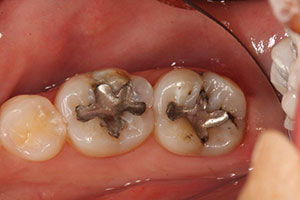 |
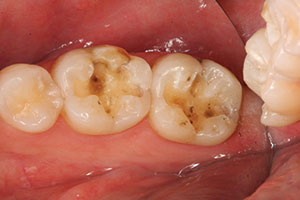 |
| Figure 1. Teeth Nos. 18 and 19 present with old, leaking amalgam restorations that are in need of replacement. | Figure 2. Old amalgams and any recurrent caries were removed. Teeth Nos. 18 and 19 were then ready for the placement of 2 different composite materials. |
 |
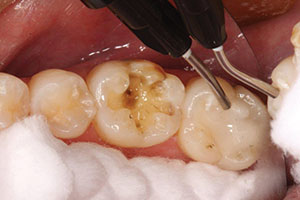 |
| Figure 3. The application of the universal bonding agent (Futurabond U [VOCO]). | Figure 4. A flowable bulk-fill composite was injected into the preparation of Tooth No. 18. |
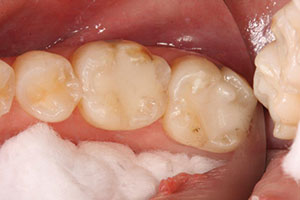 |
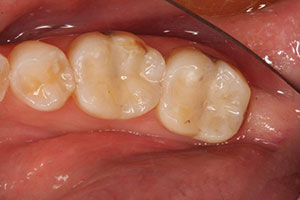 |
| Figure 5. A bioceramic-based composite restorative material (Admira Fusion x-tra [VOCO]) was placed in Tooth No. 19 in a single layer. | Figure 6. The final occlusal restorations, seen after occlusal adjustments and the final polishing steps. |
The area was then isolated using a combination of a dry angle and cotton rolls. A selective-etch technique (Vococid 35% [VOCO]) was used in this case prior to the application of the universal bonding agent (Futurabond U [VOCO]) (Figure 3). After a 20- to 30-second application of the bonding agent, it was air dried and
light cured (VALO Grand [Ultradent Products]) for 15 seconds. Both preparations were 4.0 mm or less in preparation depth, allowing for the placement of a single layer of bulk-fill, tooth-colored restorative material.
For clinical-comparison purposes, teeth Nos. 18 and 19 were filled with 2 different composite materials. Tooth No. 18 was filled with a flowable bulk-fill composite resin (x-tra base [VOCO]) (Figure 4). The composite was then light cured for 15 to 20 seconds. This flowable composite has low shrinkage stress, “non-slumping” handling properties, and excellent surface hardness, making it a good option for this clinical situation.
Tooth No. 19 was restored using a ceramic-based bulk-fill restorative material (Admira Fusion x-tra [VOCO]). The preparation was filled in a single layer, using placement techniques similar to the placement of nanohybrid composite resins (Figure 5). This ceramic-based material includes nano-ORMOCER technology, which has been demonstrated to reduce shrinkage and shrinkage stress up to 50% more compared to other bulk-fill composite resins. This should lead to less sensitivity, marginal gap leakage, and an increased longevity of the restoration. The restoration was light cured for 20 to 30 seconds.
The occlusion was then developed using an acorn-shaped diamond bur (Occlusinator [Practicon]). This bur efficiently creates natural-looking occlusal anatomy. The final anatomy and occlusion were refined using a football-shaped, 16-fluted carbide bur (Brasseler USA). The final step involved creating the final polish, which was quickly achieved using a one-step diamond polishing point (Dimanto [VOCO]) (Figure 6).
The universal shade was used for each material. Clinically, this shade provides an excellent match to the natural tooth structure. In addition, the shades of the 2 different materials demonstrated here match one another well. Over time, the restorations will be evaluated and photographed to observe how each changed during the course of clinical wear and to see if there are any differences (or similarities) with clinical aging.
CLOSING COMMENTS
Bulk-fill restorative materials have advanced to the point where clinicians can be comfortable placing these materials in thicker increments without compromising the final outcome or restoration longevity. There are many restorative options available on the market today that can provide patients with excellent long-term outcomes. Adherence to proper technique will always be critical in determining the aesthetics, function, and longevity of final restorations.
The recent advancements in aesthetic restorative materials have offered options that provide patients with excellent outcomes while, at the same time, allowing the dentist to be more predictable and efficient when creating these restorations. These increased efficiencies will reduce patient chairtime and help make practices more profitable, all without sacrificing quality of care.
References
- Vargas M. Bulk-fill resin composites. Inside Dentistry. 2018;14:84.
Dr. Radz maintains a private practice in Denver. He is a founding member of Catapult Education and the director of industry relations for SmileSource. He can be reached at radzdds@aol.com.
Disclosure: Dr. Radz receives honoraria from VOCO.
Related Articles
An Efficient and Reliable Post and Core Technique
Full-Arch, Implant-Supported Rehabilitation: A Fully Digital and Collaborative Approach
Digital Dentures: Achieving Precision and Aesthetics



